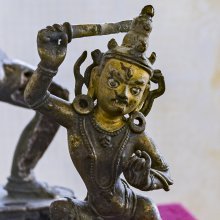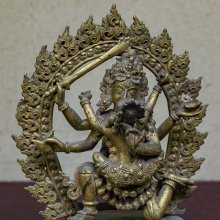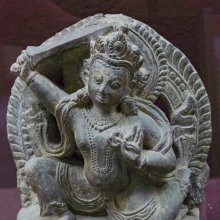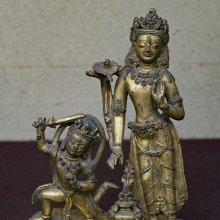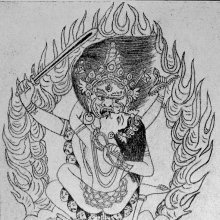Candamaharoshana, Caṇḍamahāroṣaṇa: 2 definitions
Introduction:
Candamaharoshana means something in Buddhism, Pali, Hinduism, Sanskrit. If you want to know the exact meaning, history, etymology or English translation of this term then check out the descriptions on this page. Add your comment or reference to a book if you want to contribute to this summary article.
The Sanskrit term Caṇḍamahāroṣaṇa can be transliterated into English as Candamaharosana or Candamaharoshana, using the IAST transliteration scheme (?).
Alternative spellings of this word include Chandamaharoshana.
Images (photo gallery)
In Buddhism
Tibetan Buddhism (Vajrayana or tantric Buddhism)
Source: archive.org: The Indian Buddhist Iconography1) Caṇḍamahāroṣaṇa (चण्डमहारोषण) or Caṇḍamahāroṣaṇatantra is the name of a book dealing with Buddhist iconography.—Besides the above mentioned Niṣpannayogāvalī, there are numerous Tāntric texts which furnish considerable material for the study of Buddhist iconography of the Tāntric period with which this work primarily concerns itself. Some of the more important materials can be found in the original Tantra works such [viz., Caṇḍamahāroṣaṇa-tantra], and many others. [...] Their handwritten copies can be found in the manuscript libraries such as the Durbar Library, Nepal; Asiatic Society’s Library, Bengal; University Library, Cambridge; Musee Guimet, Paris; and the Russian Academy of Sciences in Leningrad. Numerous such manuscripts are also to be found in the hundreds of Buddhist monasteries of Nepal at Kathmandu, Pattan and Bhatgaon.2
2) Caṇḍamahāroṣaṇa (चण्डमहारोषण) is another name for Caṇḍaroṣaṇa: one of the various emanations of Akṣobhya having their Sādhana described in the 5th-century Sādhanamālā (a collection of sādhana texts that contain detailed instructions for rituals).—His Colour is yellow; his Symbols are the sword and tarjanīpāśa; he has two arms.—Caṇḍaroṣaṇa is also called Mahācaṇḍaroṣaṇa, Caṇḍamahāroṣaṇa and Acala. Four Sādhanas are devoted to his worship and he is always represented in yab-yum. Prabhākarakīrti is said to be the author of one of the Sādhanas the major portion of which is is verse.
The Dhyāna (meditation instructions) of Caṇḍamahāroṣaṇa described in the Sādhanamālā as follows:
“The worshipper should think himself as Śrī-Caṇḍamahāroṣaṇa, whose colour is like that of the Atasī flower and whose second name is Acala. He is one-faced, two-armed and is squint-eyed. His face appears terrible with bare fangs. He wears a jewelled head-dress, bites his lips and wears on his crown a garland of severed heads. His eyes are slightly red, and he carries the sword in his right hand and the noose round the raised index finger against the chest in the left. His sacred thread consists of a white snake ; he is clad in tiger-skin and he wears jewels. His left leg touches the ground while the right is slightly raised. He is radiant as the sun and bears on his crown the effigy of Akṣobhya. Thus the god should be meditated upon”.

Tibetan Buddhism includes schools such as Nyingma, Kadampa, Kagyu and Gelug. Their primary canon of literature is divided in two broad categories: The Kangyur, which consists of Buddha’s words, and the Tengyur, which includes commentaries from various sources. Esotericism and tantra techniques (vajrayāna) are collected indepently.
Languages of India and abroad
Sanskrit dictionary
Source: Cologne Digital Sanskrit Dictionaries: Edgerton Buddhist Hybrid Sanskrit DictionaryCaṇḍamahāroṣaṇa (चण्डमहारोषण).—according to Bhattacharya, GOS 26 p. viii, name of a Bodhisattva, ‘the principal figure in the Tantra of that name’: Sādhanamālā 171.15, 172.2 etc. Is he not another name for, or form of, Mañjuśrī? His sādhanas follow those of the latter in Sādhanamālā; both have the name or epithet Pañcavīra (read °cīra)-kumāra, q.v. He is in any case an angry personage.
Sanskrit, also spelled संस्कृतम् (saṃskṛtam), is an ancient language of India commonly seen as the grandmother of the Indo-European language family (even English!). Closely allied with Prakrit and Pali, Sanskrit is more exhaustive in both grammar and terms and has the most extensive collection of literature in the world, greatly surpassing its sister-languages Greek and Latin.
See also (Relevant definitions)
Starts with: Candamaharoshanatantra.
Full-text: Pancavirakumara, Candaroshana, Mahacandaroshana, Khaganana, Candamaharoshanatantra, Acala.
Relevant text
Search found 3 books and stories containing Candamaharoshana, Caṇḍamahāroṣaṇa, Candamaharosana; (plurals include: Candamaharoshanas, Caṇḍamahāroṣaṇas, Candamaharosanas). You can also click to the full overview containing English textual excerpts. Below are direct links for the most relevant articles:
The Indian Buddhist Iconography (by Benoytosh Bhattachacharyya)
Stupas in Orissa (Study) (by Meenakshi Chauley)
Emanations of Aksobhya < [Chapter 5]
Guhyagarbha Tantra (with Commentary) (by Gyurme Dorje)
6. Origin of the Guhyagarbhatattvaviniścayamahātantra < [Introduction]
